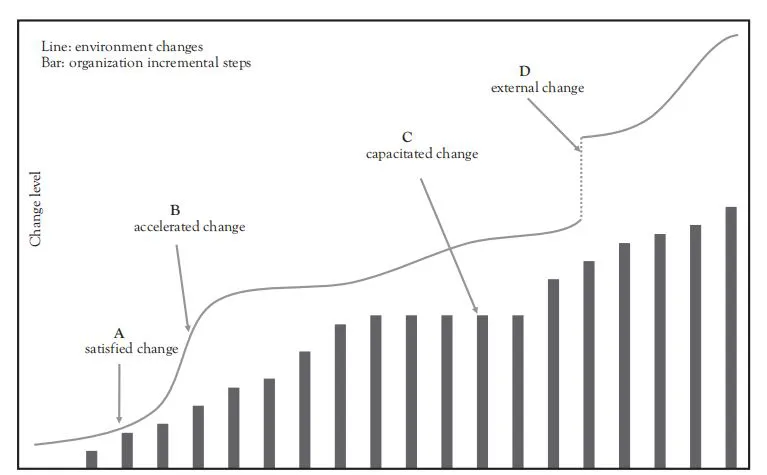![]()
CHAPTER 1
Strategic Organizational Transformation
- Strategic organizational transformations respond to shifts in the environment to establish sustainable competitive capabilities.
- 70+ percent of corporations are expected to implement organizational transformations in the foreseeable future.
- Typically, only one-third of organizational transformations are successful, with diminished capacity or elimination as a result of failure.
- Strategic organizational transformations are a specific type of project suggesting the utilization of project management practices and techniques.
- Unlike traditional project management, transformation must continually focus on the management of multiple projects, environmental uncertainty, and organizational politics.
Chapter Structure
Strategic Organizational Transformation
Organizations make continual adjustments in response to changes in external factors and influences. Adjustments vary in degree according to requirements dictated not by the organization, but by the environment in which they operate. Product portfolios must adjust according to the changing demands of consumer markets. Adjustments might be a minor response to broaden options or make feature changes that satisfy an evolving preference of customers, such as a larger number of flavor choices for soft drink offerings or switching to recyclable packaging for storage and shipping. Changes due to transformation may be far more complex, such as entering new markets to counter the erosion in sales of outdated goods or moving into the market for entertainment content instead of relying on entertainment hardware. An organization must adjust to changes in the labor force as demands on talent shift to newer disciplines, leaving a shortage of skilled workers, especially in the fields of technology and analytics. Attracting and retaining desirable talent requires that organizations adjust to attitudinal changes regarding loyalty to both company and career. The examples could continue almost indefinitely, but suffice it to say that the different sources of impetus to change include a litany of market factors, regulations, investor requirements, societal pressures, and competitors.
When organizational change involves directional factors in response to or anticipation of environmental changes, such as vision, product positioning, or operational structure, then organizations are implementing a strategic transformation (Mintzberg and Westley 1992). Formally, strategic organizational transformation refers to advanced adjustments or core makeovers conducted by organizations to establish a sustainable competitive advantage based on actual or predicted changes in the external environment. Strategic transformation alters organizational capabilities, products, systemic processes, and possibly higher features as culture and leadership. In practice, environmental changes tend to occur more rapidly than essential transformations, resulting in a misalignment between the market and the organizational direction or a lag between strategic transformations and environmental changes. When a lag occurs, an organization is forced into more rapid, revolutionary strategic transformations (Johnson, Scholes, and Whittington 2005).
Organizations strive to maintain currency and relevance through continual improvements, each representing a small adjustment, but collectively transforming the organization and meeting both past and anticipated changes to the external environment and internal conditions. However, even an organization effective at continual improvement will someday be outstripped by the speed and magnitude of changes to their environment. Figure 1.1 illustrates how incremental change can be effective up to a point, but not beyond due to the emergence of large gaps.
At the start, an organization may effectively address the needs of their customers, investors, and employees through incremental changes instead of substantial transformation. As the environment changes, indicated by the line of change level, the organization proceeds with incremental steps to address change as indicated by the bars in Figure 1.1. For a time, the responses adequately address the changes to the environment as in Point A. At Point B, the speed of environmental change accelerates, leaving the ability of an organization to rise to the level of required changes through incremental transformations. At Point C, change continues in the environment, but the organization reached its capacity to change existing systems, practices, processes, or policies; perhaps the expense of marginal change exceeds the value, or technical limitations are reached. At Point D, a major shift in the environment occurs, perhaps due to technology, regulation, or social awareness. In Cases B, C, and D, the ability of an organization to make incremental change fails to maintain the required pace. Thus, there are times when an incremental approach is effective, and other times when a more revolutionary transformation is required.
Figure 1.1 Incremental response to levels of change over time
Of course, the binary representation from incremental steps of transformation to larger revolutionary transformation is overly simplistic. The nature of incremental steps addresses long-term transformation typically associated with efficiency and profitability, while a revolutionary transformation results from challenging the beliefs of an organization. Incremental steps target adapting to smaller changes in the environment while continuing to rely on existing strengths and capabilities. Here, an organization accomplishes strategic transformation through a gradual process by making small-scale adjustments, slowly leading an organization from its current state to a future state while retaining strengths associated with operational capabilities and market advantages. Clearly, such an approach may maintain the stability of organizational operations while moving the organization to match the organizational transformation to environmental changes.
On the other hand, revolutionary transformation involves a substantial overhaul, perhaps requiring new capabilities, a new culture, and a new business model. In between incremental and revolutionary transformation lie many possibilities. Environmental change may require substantial operational improvements or product modifications, but no essential change to the business model or culture of the organization. Likewise, the reverse might also be true. Table 1.1 affords a comparative look at extreme and combined features.
Table 1.1 Incremental versus revolutionary transformatio...


